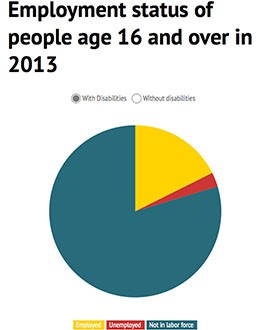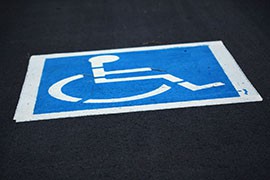Cronkite News has moved to a new home at cronkitenews.azpbs.org. Use this site to search archives from 2011 to May 2015. You can search the new site for current stories.
Employment improves, but disabled jobless rate stays stubbornly high
Editor’s Note: A previious version of this story incorrectly identified Susan Webb. She is a vice president of Arizona Bridge to Independent Living. The story below has been revised to reflect the correct information. Clients who used this story are asked to run the correction that can be found here.
WASHINGTON – While the U.S. unemployment rate fell from 7.9 percent in 2012 to 7.1 percent in 2013, the jobless rate for people with disabilities remained stubbornly above 13 percent – which comes as little surprise to advocates.
They point to a combination of factors for the problem – employers’ hesitation to hire, disabled people’s fears that a job could cost them benefits and a federal benefits system that creates a “disincentive to work.” Because of that, joblessness for the disabled was 13.2 percent in 2013, down only slightly from 13.4 percent a year earlier,according to a Bureau of Labor Statistics report.
“We’re talking about a very long-term, chronic problem,” said Carol Glazer, president of the National Organization on Disability.
Arizona reflects the broader national problems, say experts, even though no state numbers on employment for the disabled in 2013 were available. But the Census Bureau averaged unemployment for working-age people with disabilities from 2008 to 2012 and put the rate at 17.8 percent nationally for that period, while it was 18.4 percent in Arizona.
Census said the state also tracks the nation in terms of the percent of the workforce that has a disability, at 4.5 percent for both Arizona and the U.S.
Erica McFadden, a policy analyst with the Morrison Institute for Public Policy at Arizona State University, said part of the problem is a lack of state funding to let the Rehabilitation Services Administration help everyone who needs assistance.
“We actually have an indefinite waiting list for a lot of people who qualify for services because we don’t have the funding,” McFadden said.
Rehabilitation Services administrators said resources are scarce for all state agencies, but insist they are making progress by helping those people who face the most significant barriers first. The state is required to prioritize, they said, serving people with the most debilitating disabilities first and putting others on a wait list.
They said they also expect a boost from the Workforce Innovation and Opportunity Act, which reauthorizes federal spending on workforce development programs. That bill won final approval last week from the House.
Advocates said that more education – for employers and would-be workers both – could also lead to significant gains in employment of the disabled.
Susan Webb, a vice president of the Arizona Bridge to Independent Living, said that a person getting a monthly Social Security benefit of about $1,035 is barely living over the poverty line and would be reluctant to do anything to jeopardize that. That results in “less than one-half of 1 percent” of those people likely returning to work, she said.
But Webb said those people may be able to get a job and keep some benefits – they just don’t realize it.
“They don’t understand or they don’t get information about their options, and it becomes (an issue) of protecting those benefits no matter what,” she said.
McFadden said people can find a job and still keep their benefits to supplement their earnings. Education about how people with disabilities can enter the workforce should begin when they are still young, she said, so they may prepare for life beyond school.
In Arizona, people can turn to Disability Benefits 101, a privately run website that offers primers on maintaining benefits. This site has helped the state make great strides in educating people about their options, said Letitia Labrecque, administrator for Arizona’s Rehabilitation Services.
“95 percent of the time, they are shown that going back to work is actually beneficial, and that they can … work within the community and hold onto that medical insurance,” Labrecque said.
Businesses could also benefit from learning more about this untapped labor pool. Glazer said some employers have fears and misperceptions about how a person with a disability could contribute.
“It’s based merely on a lack of experience,” Glazer said of that fear. “Oftentimes, you’re just afraid of what you don’t know.”
McFadden said business leaders should learn that those stereotypes are false, and that a person with a disability can perform a job just as well as an able-bodied person.
Some employers in the state have done just that.
Steven Phillips, owner of Z Cleaners in Scottsdale, said his business has had two employees with hearing impairments and one with a learning impairment, all of whom have performed well.
“There are probably many people that are capable of doing the work,” Phillips said. “You just have to match the job to the individual so that everybody will be successful.”
Bob Enderle, director of diversity and community relations at Medtronic’s Tempe campus, said the medical device manufacturer has worked with Rehabilitation Services to hire people with visual impairments, with cognitive disabilities and others who use wheelchairs.
Accommodating those with disabilities is not as difficult as some might think, Enderle said, and resources like the federally run Job Accommodation Network make the process easier. So easy that, in many cases, managers and colleagues never notice a fellow worker’s impairment, he said.
“They can do quite complex work,” contrary to some misperceptions, Enderle said.
A job is more than just an opportunity for a paycheck, Labrecque said. A job can improve a person’s morale, provide social opportunities and even help alleviate the symptoms of a disability.
“It just has many benefits,” she said, “from beginning to end.”









